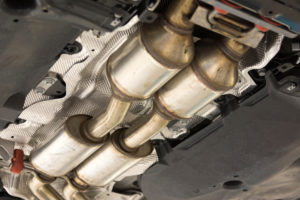People typically lock their cars when they park them to safeguard personal items and components inside the vehicle. Increasingly, however, criminals are less interested in what’s inside the car than they are in what’s underneath it — the catalytic converter.
The National Insurance Crime Bureau has reported that thefts of catalytic converters jumped by 325% in 2020 compared to 2019. Reported claims rose by more than 11,000 in 2020, and not all claims get reported.
If the catalytic converter on your vehicle is stolen, it can cost you on average up to $2,000 to replace it, and it is illegal to drive your car without one. The resulting gap in your exhaust system also makes the car run poorly until it is fixed. Depending on what type of insurance you have, it may or may not cover the theft.
 Where’s the attraction for thieves?
Where’s the attraction for thieves?
A vehicle’s catalytic converter takes in raw exhaust from the vehicle’s engine. It then converts the harmful chemicals in the exhaust to carbon dioxide, nitrogen, and water vapor. The process reduces harmful emissions into the air. Federal law has required vehicles to include catalytic converters since the 1975 model year.
The devices contain a “honeycomb” structure that, when heated up, causes a chemical reaction that converts the harmful gasses to less dangerous ones. The honeycomb is made of three rare and expensive metals — platinum, palladium, and rhodium.
Catalytic converters are attracting thieves because of the prices fetched by these metals. An ounce of rhodium sells for more than $15,000, while palladium goes for more than $2,100 an ounce and platinum is worth more than $1,000 an ounce. Online sellers of stolen catalytic converters can fetch up to $1,500; thieves net an average of $200 per unit.
Theft of catalytic converters is also a low-risk crime. A thief who knows what he’s doing can remove one in just a couple of minutes. Manufacturers do not stamp serial numbers or other identifiers on them, so a stolen converter is very difficult to trace.
The recent increase in rates of violent crime has caused police to give less priority to property crimes. Consequently, the odds of catching a thief are low.
The cost to you
In addition to the cost of purchasing and installing a new catalytic converter, the victim of theft may have a long wait. Supply chain disruptions resulting from the COVID-19 pandemic have meant that it can take weeks for a new unit to arrive.
If the catalytic converter on your vehicle is stolen, your auto insurance may pay part of the cost of replacing it if you purchased comprehensive coverage. This insurance covers loss of or damage to the vehicle from causes other than collision.
The policyholder is responsible for paying the deductible, however. In some cases, the deductible may be almost as much as the cost of replacing the converter. Call us to discuss submitting a claim.
Protecting your vehicle
You should also report the theft to the police, even if it seems unlikely that you will recover the stolen unit.
There are steps you can take to avoid becoming a victim of this crime:
- Parkin well-lit garages or lots.
- Have the vehicle identification number (VIN) engraved on the converter.
- Install a catalytic converter anti-theft device.
- Install an alarm system.
Some states are considering legislation that would crack down on catalytic converter theft. But any newly enacted laws will take some time to have an effect. In the meantime, expect the trend of increasing thefts of catalytic converters to continue while precious metal prices remain high and units can be sold with little consequence.
Take the above measures to reduce your risk, and be ready to report a theft to the police and your insurance company if it happens to you.










